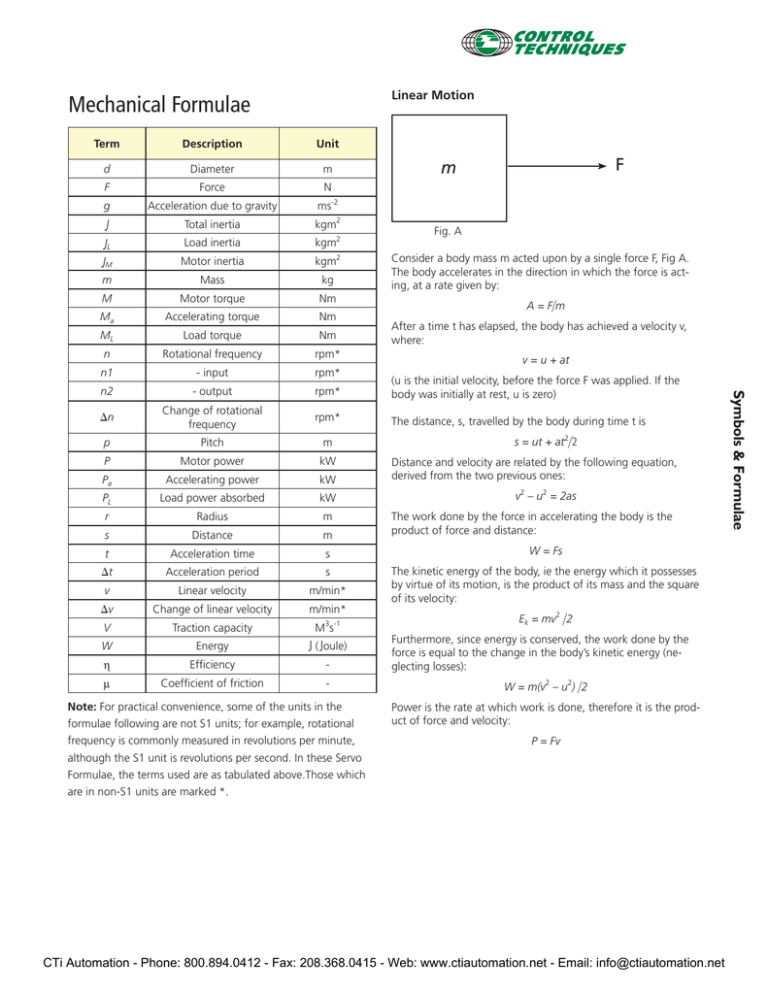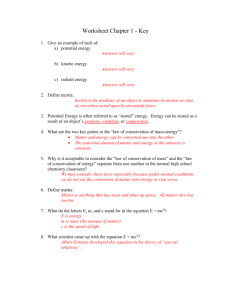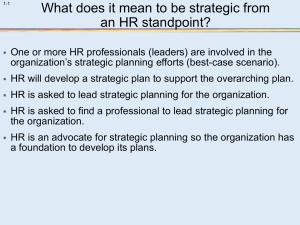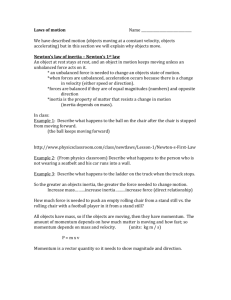Mechanical Formulae J
advertisement

www.emersonct.com 800-893-2321 Linear Motion Mechanical Formulae Term Description Unit d Diameter m F Force N g Acceleration due to gravity ms-2 J Total inertia kgm2 JL JM Load inertia kgm2 Motor inertia kgm2 m Mass kg F m Fig. A Consider a body mass m acted upon by a single force F, Fig A. The body accelerates in the direction in which the force is acting, at a rate given by: M Motor torque Nm Ma Accelerating torque Nm ML Load torque Nm n Rotational frequency rpm* n1 - input rpm* n2 - output rpm* (u is the initial velocity, before the force F was applied. If the body was initially at rest, u is zero) 욼n Change of rotational frequency rpm* The distance, s, travelled by the body during time t is p Pitch m P Motor power kW Pa Accelerating power kW PL Load power absorbed kW r Radius m s Distance m t Acceleration time s W = Fs 욼t Acceleration period s v Linear velocity m/min* 욼v The kinetic energy of the body, ie the energy which it possesses by virtue of its motion, is the product of its mass and the square of its velocity: Change of linear velocity m/min* V Traction capacity M3s-1 W Energy J ( Joule) η Efficiency - μ Coefficient of friction - After a time t has elapsed, the body has achieved a velocity v, where: v = u + at Symbols & Formulae Note: For practical convenience, some of the units in the formulae following are not S1 units; for example, rotational frequency is commonly measured in revolutions per minute, although the S1 unit is revolutions per second. In these Servo Formulae, the terms used are as tabulated above.Those which are in non-S1 units are marked *. A = F앛m s = ut + at2앛2 Distance and velocity are related by the following equation, derived from the two previous ones: v2 – u2 = 2as The work done by the force in accelerating the body is the product of force and distance: Ek = mv2 앛2 Furthermore, since energy is conserved, the work done by the force is equal to the change in the body’s kinetic energy (neglecting losses): W = m(v2 – u2) 앛2 Power is the rate at which work is done, therefore it is the product of force and velocity: P = Fv 401 CTi Automation - Phone: 800.894.0412 - Fax: 208.368.0415 - Web: www.ctiautomation.net - Email: info@ctiautomation.net www.emersonct.com 800-893-2321 Rotational or Angular Motion M=Fr r Fig A.11 The concept of torque M Angle and angular velocity are related by the following equation: 2 - o2 = 2 The work done in accelerating the body is the product of torque and angle of rotation: W = M A force acting perpendicular to a pivoted lever, Fig A.11, causes a turning effect or torque at the fulcrum.The torque is the product of the force and the radius at which it is applied. M = Fr If a torque is applied to a body which is free to rotate, as in Fig A.12, an acceleration results in a way which is analogous to the example of linear motion above. Indeed a similarity will be noticed between the equations of motion. Symbols & Formulae Any body which is capable of rotating possesses a property known as Moment of Inertia which tends to resist acceleration in the same way as does the mass of a body in linear motion. The moment of inertia is related not only to the mass of the body, but also to the distribution of that mass with respect to radius. The moment of inertia of a solid cylinder of radius r is given by: The kinetic energy of the body is the product of its moment of inertia and the square of its angular velocity: Ek = J2 2 Since energy is conserved, the work done is equal to the change in kinetic energy (neglecting losses): W = J(2 - o2) 2 Power is the product of torque and angular velocity, i.e. the rate at which work is being done: P = M Relationship between linear and angular motion Consider a body of mass m moving in a circle of radius r with an angular velocity , Fig A.13. When the body has rotated through an angle , it has covered a distance s along circumference of the circle, where: J = mr 2 2 m By comparison, the moment of inertia of a hollow cylinder, of inner and outer radii respectively, is as follows: v s J = m(ro - r i ) 2 2 2 r Fig A.13 Relationship between linear and angular motion It can be seen that, for a given outer radius, the moment of inertia of a hollow cylinder is greater than that of a solid cylinder of the same mass. In Fig A.12, a body having a moment of inertia J is acted upon by a torque M. Its angular acceleration is: = M/J Fig A.12 The Action of torque on a body J Similarly, the tangential velocity or peripheral speed v, being the quotient of distance and time, is given by: v = s/t = r/t Angular velocity w is the quotient of angle and time; M After a time t has elapsed, the angular velocity, (rate of change of angle) is given by: = o + t (wo is the initial angular velocity, before the torque M was applied. If the body was initially at rest, o is zero) The angle, g, through which the body rotates in time t is: = ot + t2/2 w = /t Therefore v = wr Similarly, for acceleration: a = v/t = wr/t =w Therefore a = r The moment of inertia is given by 402 J = mr2 CTi Automation - Phone: 800.894.0412 - Fax: 208.368.0415 - Web: www.ctiautomation.net - Email: info@ctiautomation.net www.emersonct.com 800-893-2321 The Effect of Gearing INERTIA When calculating the torque required to accelerate or decelerate the moving parts of a machine, it is necessary to take into account any gearing which introduces a ratio between the speeds of different parts. It is unusual to calculate the moment of inertia transferred to the motor shaft, since this figure may be added arithmetically to the motor inertia to arrive at a figure for the total inertia of the system. Fig A.14 illustrates a motor, having a moment of inertia J1, driving a load with inertia J2, via a gearbox. Body Moment of Inertia(J) Axis Uniform rod (length I) If the gearbox has a ratio k, then the relationship between input and output angular velocities is as follows: Polar ω1 = kω 2 Neglecting losses, the input and output torques are related thus: M1 = M2 /k Uniform hoop (radius r, diameter d) diameter Symbols & Formulae The load inertia reflected back through the gearbox to the motor shaft is reduced by a factor equal to the square of the gear ratio. Therefore the total inertia which the motor has to overcome is given by: J = J1 + J2 k2 MOTOR Polar LOAD GEARBOX M1 M2 J1 J2 1 2 Uniform thin disk (radius r, diameter d) diameter Fig A.14 The effect of gearing between motor and load b Rectangular Plate d centre h Triangular Plate centre h/3 b 403 CTi Automation - Phone: 800.894.0412 - Fax: 208.368.0415 - Web: www.ctiautomation.net - Email: info@ctiautomation.net www.emersonct.com 800-893-2321 Body Moment of Inertia(J) Axis Gear Reduction axis Solid circular cylinder (radius r) Belt Drive centre Symbols & Formulae axis Screw Drive Cylindical shell (no ends) centre Inertia InertiaMatching Matching 1. For extremely fast acceleration, use 1:1 inertia match. diameter Uniform Solid Sphere (radius r) 1. For Forminimum fast acceleration, use use 1:1 reflected inertia match. 2. peak power, load inertia 2.5 times motor inertia. 2. For minimum peak power, use reflected load inertia 3. general “rule of thumb” is to avoid inertia higher than 5 2.5The times motor inertia. times motor inertia, however “Motion Made Easy” space-state control enables mismatches to 10higher times motor 3. Generally avoid load inertia than 5inertia. times motor inertia diameter Uniform (radius r) 404 CTi Automation - Phone: 800.894.0412 - Fax: 208.368.0415 - Web: www.ctiautomation.net - Email: info@ctiautomation.net www.emersonct.com 800-893-2321 Area,Volume and Arc Length Servo Formulae MotorTorque Constant Sphere: Motor InputVolts Circular Cone: Motor Regulation (h= vertical height, I = slant height, r = base radius & I2=h2+r 2) DevelopedTorque = RMSTorque, Distance, Angle(m, rads) Circular Cylinder: Velocity, (m/s, rads/second) Pyramid: Linear Rotary x (base) x (perpendicular height) Symbols & Formulae Acceleration, (m/s2, rads/s2) Force (N) Torque (Nm) Circle: Power (W) Frustrum of Cone: Kinetic Energy (J) Motion Equations Tr iangle: Velocity: Distance: Eclipse: Spherical cap: 405 CTi Automation - Phone: 800.894.0412 - Fax: 208.368.0415 - Web: www.ctiautomation.net - Email: info@ctiautomation.net







